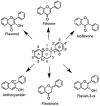Polyphenols as the Main Compounds Influencing the Antioxidant Effect of Honey-A Review
- PMID: 39408935
- PMCID: PMC11477350
- DOI: 10.3390/ijms251910606
Polyphenols as the Main Compounds Influencing the Antioxidant Effect of Honey-A Review
Abstract
Honey is one of the most valuable components of the human diet. It is considered to be a functional food with health-promoting properties. Honey has bactericidal and bacteriostatic effects; is used to treat wounds and ulcers; relieves stress; supports the treatment of diseases of the digestive and respiratory systems; improves kidney function; and aids in convalescence. The healing and prophylactic effects of honey are closely related to its chemical composition. According to the literature, honey contains over 300 substances belonging to various groups of chemical compounds, some with antioxidant activity, including vitamins and phenolic compounds, mainly flavonoids and phenolic acids. This article provides insight into honey's chemical composition and its pro-health activities. The antioxidant properties of honey were prioritized.
Keywords: antioxidant activity; bioactive substances; phenolic compounds; pro-health properties.
Conflict of interest statement
The authors declare no conflicts of interest.
Figures
Similar articles
-
Establishing Relationship between Vitamins, Total Phenolic and Total Flavonoid Content and Antioxidant Activities in Various Honey Types.Molecules. 2021 Jul 21;26(15):4399. doi: 10.3390/molecules26154399. Molecules. 2021. PMID: 34361551 Free PMC article. Review.
-
Bioactive Components and Antioxidant and Antibacterial Activities of Different Varieties of Honey: A Screening Prior to Clinical Application.J Agric Food Chem. 2019 Jan 16;67(2):688-698. doi: 10.1021/acs.jafc.8b05436. Epub 2019 Jan 4. J Agric Food Chem. 2019. PMID: 30575387
-
Influence of Season, Hive Position, Extraction Method and Storage Temperature on Polyphenols and Antioxidant Activity of Croatian Honey.Molecules. 2025 Feb 17;30(4):919. doi: 10.3390/molecules30040919. Molecules. 2025. PMID: 40005232 Free PMC article.
-
The Profile of Polyphenolic Compounds, Contents of Total Phenolics and Flavonoids, and Antioxidant and Antimicrobial Properties of Bee Products.Molecules. 2022 Feb 15;27(4):1301. doi: 10.3390/molecules27041301. Molecules. 2022. PMID: 35209088 Free PMC article.
-
Honey's Antioxidant and Antimicrobial Properties: A Bibliometric Study.Antioxidants (Basel). 2023 Feb 8;12(2):414. doi: 10.3390/antiox12020414. Antioxidants (Basel). 2023. PMID: 36829972 Free PMC article. Review.
Cited by
-
Nanotechnology-Based Plant Antioxidants: A Current Literature Review on Bioavailability and Oxidative Stress.Curr Nutr Rep. 2025 Aug 6;14(1):98. doi: 10.1007/s13668-025-00689-2. Curr Nutr Rep. 2025. PMID: 40768104 Review. No abstract available.
-
Honey as a Natural Antimicrobial.Antibiotics (Basel). 2025 Mar 1;14(3):255. doi: 10.3390/antibiotics14030255. Antibiotics (Basel). 2025. PMID: 40149066 Free PMC article. Review.
-
The In Vitro Antioxidant and Immunomodulatory Effects of the Irish Monofloral Ivy and Heather Honey Varieties.Int J Mol Sci. 2025 Apr 11;26(8):3625. doi: 10.3390/ijms26083625. Int J Mol Sci. 2025. PMID: 40332151 Free PMC article.
-
Comparison of the characteristics of phenolic compounds in Se-enriched kiwifruit and conventional kiwifruit.Food Chem X. 2025 Apr 10;27:102453. doi: 10.1016/j.fochx.2025.102453. eCollection 2025 Apr. Food Chem X. 2025. PMID: 40276232 Free PMC article.
-
Selected honey as a multifaceted antimicrobial agent: review of compounds, mechanisms, and research challenges.Future Microbiol. 2025 May-Jun;20(7-9):589-610. doi: 10.1080/17460913.2025.2498233. Epub 2025 Apr 28. Future Microbiol. 2025. PMID: 40293032 Review.
References
-
- DIRECTIVE2014/63/EU of the European Parliament and of the Council of 15 May 2014 Amending Council Directive 2001/110/EC Relating to Honey, Official Journal of the European Union L 164/1. 2014.
-
- Laaroussi H., Bouddine T., Bakour M., Ousaaid D., Lyoussi B. Physicochemical Properties, Mineral Content, Antioxidant Activities, and Microbiological Quality of Bupleurum spinosum Gouan Honey from the Middle Atlas in Morocco. J. Food Qual. 2020;2020:7609454. doi: 10.1155/2020/7609454. - DOI
-
- Bobis O., Moise A.R., Ballesteros I., Reyes E.S., Durán S.S., Sánchez-Sánchez J., Cruz-Quintana S., Giampieri F., Battino M., Alvarez-Suarez J.M. Eucalyptus Honey: Quality Parameters, Chemical Composition and Health-Promoting Properties. Food Chem. 2020;325:126870. doi: 10.1016/j.foodchem.2020.126870. - DOI - PubMed
-
- Boussaid A., Chouaibi M., Rezig L., Hellal R., Donsì F., Ferrari G., Hamdi S. Physicochemical and Bioactive Properties of Six Honey Samples from Various Floral Origins from Tunisia. Arab. J. Chem. 2018;11:265–274. doi: 10.1016/j.arabjc.2014.08.011. - DOI
Publication types
MeSH terms
Substances
LinkOut - more resources
Full Text Sources
Medical



